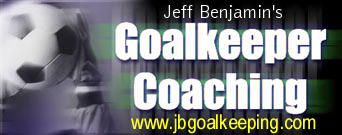
|
"Outstanding keeper instruction. This is a must for goalkeepers and coaches." —Ottawa Internationals S.C. web site, Ottawa, Canada |

|

|
Top |
Goalkeeping Tips, Tidbits and Random Thoughts
An athlete talking to themsleves during competition is hardly a new phenomenon.... The talk does not have to be vocal. By merely thinking you are talking to yourself and sending a message.
-- Tony DiCicco, Goalkeeper Soccer Training Manual
If you have a question, comment or rebuttal you'd like to see addressed here, send me email. I will post your mail to the blog at my discretion unless you specify otherwise.
First line of attack
Although soccer doesn't lend itself to statistical analysis as well as many other sports, many companies are trying to bring a more quantitative approach to the game. Computer software makes it possible to record events and their position on the field in real time and produce meaningful conclusions. In fact, I use stat-keeping software myself for the soccer teams I coach, although not to the level that many top clubs do. Data like passes completed/lost, number of passes between certain players, and the times and areas of the field where these happen can show an interesting picture of a game with insights that might not be apparent at first.However, when it comes to goalkeepers it is even more difficult to find meaningful statistics. Shots saved vs shots on goal is one obvious one, but doesn't always tell how effective a goalkeeper really is. The best goalkeepers keep their defense in shape and are well positioned themselves, so the opportunity for a shot never even presents itself.
I ran across a series of player analyses done by a company called Softsport. They did an analysis of Peter Schmeichel to see what made him one of the greatest keepers ever. They selected six attacking categories (distribution) and four defensive categories (shot stopping and cutting out passes and crosses).
It's a bit interesting, but no real insights IMHO, at least on the defensive side. "Intercepted Passes", "Shots saved", "Corner kicks saved" and "Goals against" don't really provide much of a view of a keeper's game.
One thing that caught my eye on the attacking side was that Schmeichel was credited with an average of one pass per game that led to a shot on goal. I think that's great number, and shows that every keeper ought to be looking for the chance to attack as soon as they get the ball into their hands.
I think an even better stat might be "Scoring chances created". A good attack might not lead to a direct shot on goal and still be a great scoring opportunity. Personally, I strive to set up 2-3 chances at the other end every game, by quickly finding open players in a position to counter-attack. In indoor matches, that number goes up even more, and I'm often disappointed if one or two goals a game don't come as the result of my distribution, whether it's with hands or feet.
We all know the goalkeeper is the "last line of defense", but we can never forget we're also the "first line of attack."
Labels: Tactics
A good goalkeeper is as important as a good striker
"Brian Clough used to say that a good goalkeeper is as important to a great team as a good striker and I agree absolutely," writes Andy Gray over at Soccer365. I have to say I concur.Labels: Goalkeeping News and Analysis
Analogies
More analogies that I use when training goalkeepers:- If you've ever sung in a choir or played a wind instrument and struggled to hit a high note, your instructor might have told you to think about trying to come down from above to the note, rather than straining upwards to hit it. It's a mental trick that I find helpful when going up to catch high balls. Ideally, you want to get your fingers a bit over the top of the ball. Otherwise, the ball can roll off your fingers and over them into the net.
- When cushioning the ball, you need to get your arms out to meet the ball in front of you, then "pull" it in as your elbows bend. Another analogy for cushioning the ball is a squid grabbing a fish. A squid doesn't shoot out its tentacles and slap the fish; it grabs it way out in front, secures it with its suckers, and then pulls it in for dinner. This is a great analogy for younger kids. Then the rest of the practice I remind them to "be the squid."
Labels: Catching
Point guards and shortstops
I have heard it said that if your team lacks a goalkeeper, recruit a point guard or shortstop. Both positions, for basketball and baseball/softball respectively, require good hands, quick feet and a sharp mind. Shortstops also have no fear of diving for balls. Well, I got to see that old saw put into action tonight.My high school JV team was playing indoors and the normal keeper likes to get some field time too. So another girl volunteered to play goal for a half. This girl also plays softball, so I asked her what position. "Shortstop," she said. "Perfect!" I replied. She did an excellent job in a difficult game where we were overmatched. The only disconcerting thing was seeing her scooping up a rolling ball as if she had a baseball glove on. I must say the goalkeeping technique is a bit different....
Labels: Miscellaneous
Inside the lines
If you ever pop over to The Guardian Unlimited's soccer pages, you may notice a regular feature called The Gallery. People do PhotoShop-ed send-ups of various soccer figures each week. Goalkeepers, of course, don't get off the hook. There are galleries of Oliver Kahn, Jens Lehman, Fabien Barthez, David James and David Seaman along with those of players, coaches, owners and even referees.The most recent contest was a goalkeeper again, Roy Carroll. At the risk of trouncing all over professional courtesy towards my fellow goalkeeper, I submitted a Carroll spoof that I thought was quite brilliant. And the Guardian agreed! My entry won a prize!

"If Roy Carroll can't keep things inside the lines, why should I?"
(With all due respect, I'm sure I've made many more howlers than Carroll. Mine are just a little lower profile.)
Labels: Miscellaneous
Rubber goal
Everyone keeper occasionally has a day where they wish their goal-line looked like this:
Apparently that's what it looked like to Roy Carroll earlier this week.
Labels: Matchday observations
Analogies to other sports
Analogies to other sports are something I use when coaching. Basic athletic techniques from many sports share much in common with soccer—especially goalkeeping. Stance, balance, sprinting, and catching are common elements. I have several analogies I use regularly.- Going back on a ball hit over your head is done much like a baseball outfielder would do it. You go back using a crossover step and keep your head and shoulders as square to the field as possible in order to see and track the ball.
- In order to fully cushion the ball when catching, the keeper needs to have their hands out and ready, arms extended, to meet the ball and draw it in using the elbows to take the pace from the ball. This is a bit like the reverse of setting up for a tennis or racquetball stroke: the racquet must already be back and prepared before the ball arrives to transfer the power to the ball effectively.
- When coaching dribbling to field players, space must be exploited quickly when it opens up. The dribbler must "explode" through any gap or past defenders, much like an American football running back must "hit the hole" hard in order to get past the first line of defense into the clear.
- Field players need to learn to be dynamic in front of goal in order to get open to score. I encourage slashing, diagonal runs, especially from deep and checking to the ball carrier. The basketball equivalent is the "cut to the hoop", creating a passing lane and then receiving the ball and driving towards the basket.
Labels: Catching, Miscellaneous
Favorite quotes
Every coach develops a "library" of their favorite sayings. They might be little mnemonic devices to help remember a particular technique or tactic, bits of advice, or motivational quotes. Some will be ones the coach has come up with, others might be from famous coaches or other famous figures. Here are a few motivational quotes I particularly like. I will stick one on any handouts I give players, or perhaps use them with individual players when they seem appropriate."Don't let what you cannot do interfere with what you can do."
—John Wooden
"One hundred percent of the shots you don't take don't go in."
—Wayne Gretzky
"We are what we repeatedly do. Excellence, then, is not an act, but a habit."
—Aristotle
"It's not the will to win that matters -- everyone has that. It's the will to prepare to win that matters."
—Paul "Bear" Bryant
"If you can't get out of it... get into it!"
—Hurricane Island Outward Bound slogan
Labels: Miscellaneous, Psychology